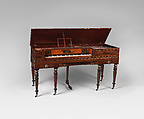Square Piano
Babcock, Appleton and Babcock American
Not on view
Alpheus Babcock was a Boston piano maker who later moved to Philadelphia. He is most famous for his invention of a cast iron frame for his square piano, which he patented in 1825. The cast iron frame would become the standard for pianos of all types and sizes. Alpheus established his first company in 1809 along with his brother Lewis. In 1811, he partnered with the builder Thomas Appleton, who is best known for his pipe organs, including an example from 1830 that is also in the collection of The Metropolitan Museum. This beautiful example comes from the period of the partnership of the Babcock brothers with Appleton, predating the invention of the cast iron frame.
Technical description: This square piano has a rectangular body with stained mahogany veneer and six screw-on reeded legs, four in the front and two in the rear. The keyboard is to the left of the center of the instrument and there are the compass is five and a half octaves (FF-c4) with ivory topped natural keys and ebony accidentals. Three drawers (2 small ones on either side of a larger in-curved drawer) below the keyboard have floral wreath, brass mounts and pulls. A single pedal lefts all of the dampers. In the center of the nameboard is written "Babcock, Appleton, & Babcock / Boston" with a cornucopia on either side. At the ends of the nameboard are floral openwork designs. The lid is supported by a single prop stick that is connected to the folding music desk.
This image cannot be enlarged, viewed at full screen, or downloaded.

